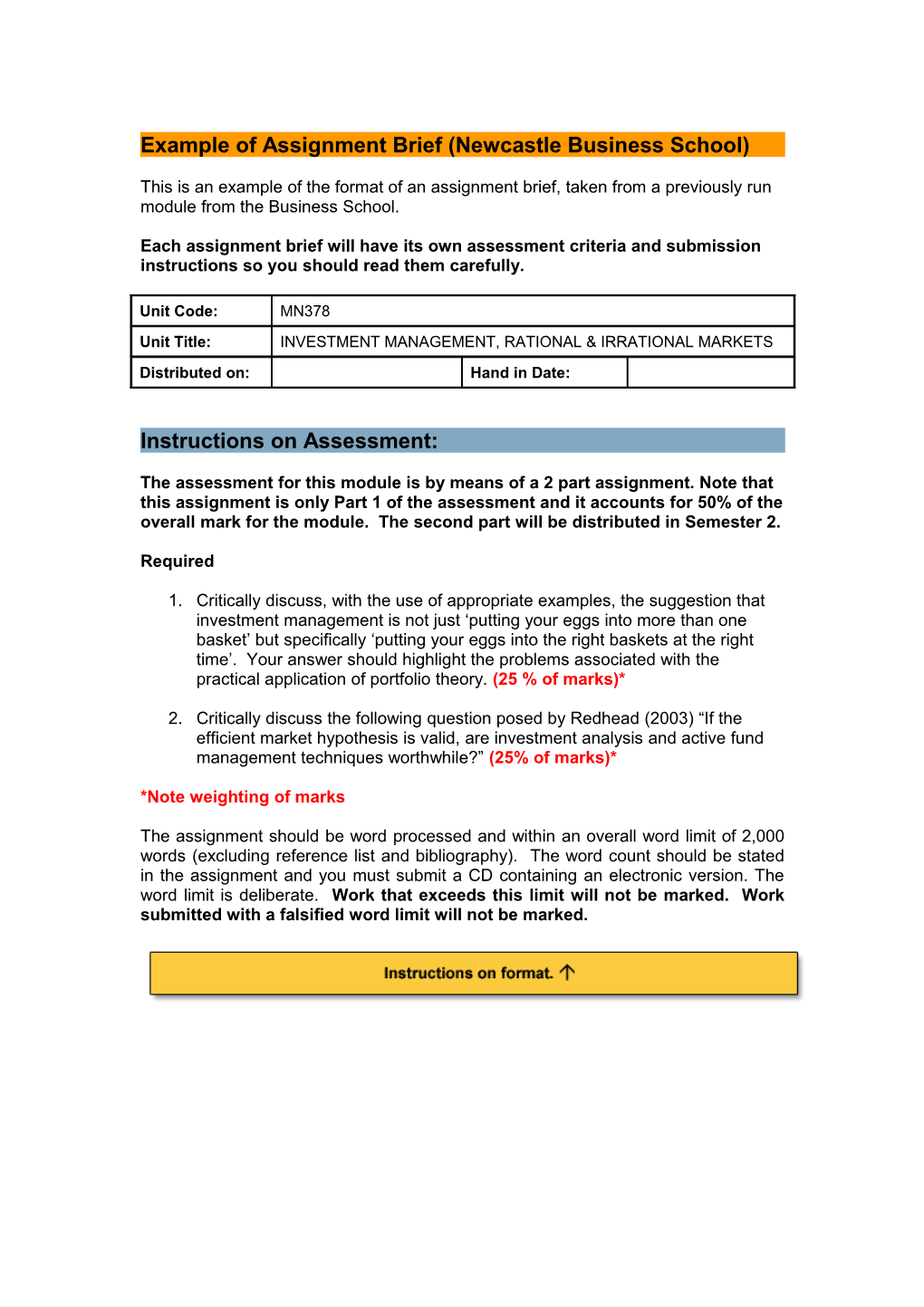Example of Assignment Brief (Newcastle Business School)
This is an example of the format of an assignment brief, taken from a previously run module from the Business School.
Each assignment brief will have its own assessment criteria and submission instructions so you should read them carefully.
Unit Code: / MN378Unit Title: / INVESTMENT MANAGEMENT, RATIONAL & IRRATIONAL MARKETS
Distributed on: / Hand in Date:
Instructions on Assessment:
The assessment for this module is by means of a 2 part assignment. Note that this assignment is only Part 1 of the assessment and it accounts for 50% of the overall mark for the module. The second part will be distributed in Semester 2.
Required
- Critically discuss, with the use of appropriate examples, the suggestion that investment management is not just ‘putting your eggs into more than one basket’ but specifically ‘putting your eggs into the right baskets at the right time’. Your answer should highlight the problems associated with the practical application of portfolio theory. (25 % of marks)*
- Critically discuss the following question posed by Redhead (2003) “If the efficient market hypothesis is valid, are investment analysis and active fund management techniques worthwhile?” (25% of marks)*
*Note weighting of marks
The assignment should be word processed and within an overall word limit of 2,000 words (excluding reference list and bibliography). The word count should be stated in the assignment and you must submit a CD containing an electronic version. The word limit is deliberate. Work that exceeds this limit will not be marked. Work submitted with a falsified word limit will not be marked.
In order to complete the tasks you will need to refer to a variety of ACADEMIC information sources such as textbooks, articles and the internet. As well as testing your ability to explore publicly available sources of information, the assessment requires you to develop skills in the analysis and synthesis of information. Analysis requires you to critically examine information and identify important issues. Synthesis requires you to summarise that analysis in a succinct and cogent manner. To help you in writing this assignment, we would that you make use of thevarious help guides and tutorials available via Northumbria Skills Plusat:
for example:
- Finding quality information – where, why and how
- Academic writing and critical analysis
References to relevant academic theory and research findings should be provided and cited appropriately.
Referencing your work
The Harvard (Northumbria) method of referring to publications and of arranging references uses the author's name and the date of the publication. References are listed at the end of the text in alphabetical order by author's name. The general format of a journal article reference is shown below:
Smith, J. (1999) 'How to succeed!' Journal of Entrepreneurs, 1 (2), pp.34-56
Author/s name and initials are listed first, followed by year of publication in brackets. Then there is the title of article and the journal where article appears, which is in italics. Finally, state the volume and issue number (in brackets) along with the pages where article can be located.
For further help access the Referencing materials available from Northumbria Skills Plus.
Plagiarism and Cheating
Your attention is drawn to the University’s stated position on plagiarism. THE WORK OF OTHERS THAT IS INCLUDED IN THE ASSIGNMENT MUST BE ATTRIBUTED TO ITS SOURCE (a list of references and bibliography must be submitted).
Please note that this is intended to be an individual piece of work. Ensure that you read through your work prior to submission.For some assignments you may be asked to use the University Plagiarism detection service ‘Turnitin’. Action will be taken where a student is suspected of having cheated or engaged in any dishonest practice. Students are referred to the University regulations on plagiarism and other forms of academic irregularity. Students must not copy or collude with one another or present any information that they themselves have not generated.
For more information on Plagiarism see the relevant section in Skills Plus.
Submission of Assessment:
This assignment must be submitted via NBS Reception. You should submit BOTH a printed and an electronic version (on a CD) of your work accompanied by an Assessed Work Form, which must be completed in full. The assignment will not be accepted by Reception unless the form is completed correctly.
Marked assignments will not be returned to students. It is advisable to retain a copy of your assignment for your own records. Your mark will be returned on the Assesses Work Form via reception.
Learning Outcomes and Transferable skills:
This assessment will fully or partially satisfy the following learning outcomes
(as stated on the teaching and learning plan):
- discuss, analyse and critically evaluate traditional and non-traditional investment theories;
- critically discuss the issues arising from the application of different investment strategies;
- discuss and appraise the inter-relationship between theories and strategies;
The assessment will also assist in the development of the following transferable skills
Assessment Criteria (NBS - Newcastle Business School)
The first column indicates the general assessment criteria used within NBS the second column indicates the specific criteria used when marking your assessment.
